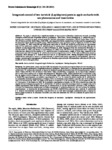Por favor, use este identificador para citar o enlazar este ítem:
http://www.alice.cnptia.embrapa.br/alice/handle/doc/943054Registro completo de metadatos
| Campo DC | Valor | Lengua/Idioma |
|---|---|---|
| dc.contributor.author | PASTORI, P. L. | pt_BR |
| dc.contributor.author | ARIOLI, C. J. | pt_BR |
| dc.contributor.author | BOTTON, M. | pt_BR |
| dc.contributor.author | MONTEIRO, L. B. | pt_BR |
| dc.contributor.author | STOLTMAN, L. | pt_BR |
| dc.contributor.author | MAFRA-NETO, A. | pt_BR |
| dc.date.accessioned | 2012-12-19T11:11:11Z | pt_BR |
| dc.date.available | 2012-12-19T11:11:11Z | pt_BR |
| dc.date.created | 2012-12-19 | pt_BR |
| dc.date.issued | 2012 | pt_BR |
| dc.identifier.citation | Revista Colombiana de Entomología, Bogotá, v. 38, n. 2, p. 224-230, 2012. | pt_BR |
| dc.identifier.uri | http://www.alice.cnptia.embrapa.br/alice/handle/doc/943054 | pt_BR |
| dc.description | The apple is attacked by a significant number of insect pests in Brazilian commercial orchards, including Bonagota salubricola and Grapholita molesta (Lepidoptera: Tortricidae). Sexual disruption of B. salubricola and G. molesta was evaluated in apple orchard using the flowable pheromone formulations, SPLAT Grafo+Bona (SG+B), SPLAT Attract and Kill Grafo+Bona (SAKG+B), and compared with the standard insecticides used for management in the Integrated Apple Production (IAP) system. Both formulations were applied at a rate of 1kg/ha on October 10, 2005 and December 13, 2005 using 300 and 1000 point sources/ha of SG+B and SAKG+B, respectively in experimental units of 7 ha. Adult male captures of B. salubricola and G. molesta were evaluated weekly in Delta traps with specific synthetic sex pheromone from October 10, 2005 to February 14, 2006. Damage to fruits was evaluated on November 21 and December 21, 2005, and January 25 and February 14, 2006. In the SPLAT treated experimental units a significant reduction was observed in the number of B. salubricola and G. molesta males caught in Delta traps compared to the experimental unit IAP. Damage by B. salubricola at harvest ranged from 1.63 to 4.75% with no differences between treatments, while damage by G. molesta was near zero in all experimental units. Mating disruption using SG+B and SAKG+B was sufficient to control B. salubricola and G. molesta with results equivalent to IAP guidelines. This technology is promising for management of both pests in Brazilian apple orchards with immediate reduction of 43% in the number of insecticide applications. | pt_BR |
| dc.language.iso | eng | eng |
| dc.rights | openAccess | eng |
| dc.subject | Atrativo sexual | pt_BR |
| dc.subject | Controle | pt_BR |
| dc.title | Integrated control of two tortricid (Lepidoptera) pests in apple orchards with sex pheromones and insecticides. | pt_BR |
| dc.type | Artigo de periódico | pt_BR |
| dc.date.updated | 2016-08-30T11:11:11Z | pt_BR |
| dc.subject.thesagro | Fruticultura | pt_BR |
| dc.subject.thesagro | Maçã | pt_BR |
| dc.subject.thesagro | Praga de planta | pt_BR |
| dc.subject.thesagro | Lagarta | pt_BR |
| dc.subject.thesagro | Controle Integrado | pt_BR |
| dc.subject.thesagro | Feromônio | pt_BR |
| riaa.ainfo.id | 943054 | pt_BR |
| riaa.ainfo.lastupdate | 2016-08-30 | pt_BR |
| dc.contributor.institution | PATRIK LUIZ PASTORI, UFCE; CRISTIANO JOÃO ARIOLI, EPAGRI; MARCOS BOTTON, CNPUV; LINO BITTENCOURT MONTEIRO, UFPR; LYNDSIE STOLTMAN, ISCA TECHNOLOGIES; AGENOR MAFRA-NETO, ISCA TECHNOLOGIES. | pt_BR |
| Aparece en las colecciones: | Artigo em periódico indexado (CNPUV)  | |
Ficheros en este ítem:
| Fichero | Descripción | Tamaño | Formato | |
|---|---|---|---|---|
| RCdE2012v38n2a10pp224230IntegratedFINAL2011106.pdf | 3,96 MB | Adobe PDF |  Visualizar/Abrir |









